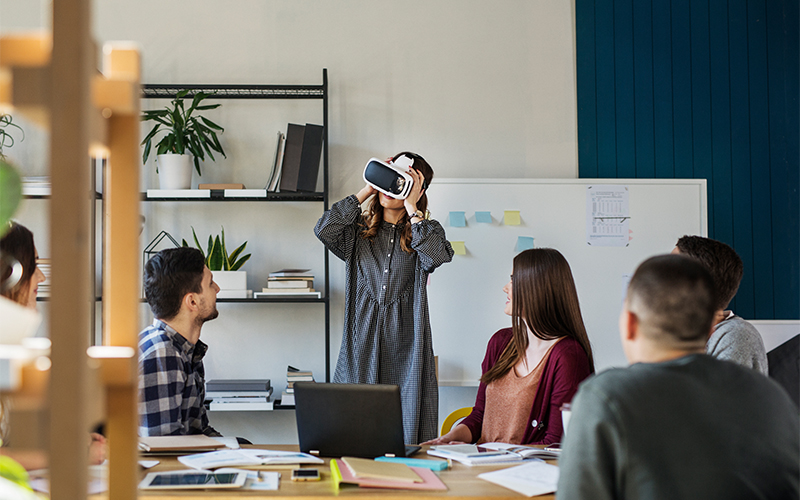Education Technology Services
The case for technology-based formative assessment
Educators are always interested in knowing which students grasped the lessons, who has mastered a new idea, and who requires additional assistance. How do you know if your students understood the course material? You can either continuously monitor them in a classroom setting (formative assessment) or evaluate their learning at the end of the course via final tests and projects (summative assessment). Teachers accomplished all of this organically in a physical classroom as they moved around the room, talked to their students, and evaluated their work.
For several years, innovative educators have used technology for assessments, but starting March 2020, all instructors have been required to use it.* Disruptions over the past two years and the sudden shift to an online learning environment have made it challenging to gauge students' learning and comprehension. But, in a meaningful, long-term, and scalable approach, how can you employ technology tools to verify a student’s understanding?
Technology to the rescue
Continuous contact between teachers and students through observations, questioning, and conversations are included in formative assessments. These encounters provide teachers with crucial information about their students' academic and social aptitude. Teachers should use technology for assessment in the classroom as this is the best way to help minimise learning loss as well as improve the effectiveness of formative assessments in the future.
The advantage of technology-based assessments
Traditional formative assessments require teachers to assess and grade the students' answers before offering feedback. This is time consuming and can potentially delay a student's learning curve. On the other hand, a technology-based assessment helps with instant feedback for the students and real-time reporting of results to the teachers.
A formative-assessment technique could be as simple as having students raise their hands if they understood a newly introduced concept. Alternatively, it could be as complex as having students complete a write-up of their understanding of a topic, which the teacher then reviews and comments on.
While formative evaluations assist teachers in identifying learning needs and difficulties, they also assist students in developing a better awareness of their academic strengths and shortcomings. When students understand what they excel in and where they need to improve, they can take charge of their learning and intellectual development.
Moreover, different feedback channels — online chats, email, or videoconferencing — allow teachers to connect with students immediately and share resources that can help them. This paves the way for immediate and personalised assistance, instructions, and resources for the students. Some of the key benefits of using technology for assessments in the classroom are:
- Learning new technologies:
- Availability of several online resources:
- Automated feedback system:
Using technology-based assessment tools allows students and teachers to learn new technologies to navigate the changing technological world.
An infinite number of resources are available online. A technology-based assessment allows integrating these resources into the course material to make learning more effective and engaging.
Students can identify where they went wrong and what they did well, get their test results, and receive feedback faster with a technology-based formative assessment. This can give them more time to focus on their learning and improve their abilities.
Technology-based assessment strategies
Virtually, every student now uses a device in today's online learning environment. You can leverage the power of these devices to assess the learning of your students:
- Embed questions into learning material:
- Using screencasts:
With the help of interactive presentations, you can embed questions, polls, or quizzes into your lessons. Placing a poll at the beginning, embedding a question in the middle, or integrating a quiz at the end of the lesson can enhance the students' learning at every stage.
Screencasts allow students to document everything happening on their screens along with an audio recording. A screencast captures the entire process from beginning to end, enabling you to view what students wrote on their page and what they were considering as they narrate their steps and record their voice.
How can Infosys BPM help?
Infosys BPM Edutech Services offer easy-to-use assessment tools to integrate technology-based assessment practices in your classroom. Integrate technology in your assessments and classroom with Infosys BPM and improve the effectiveness of your formative assessments.
*For organisations on the digital transformation journey, agility is key in responding to a rapidly changing technology and business landscape. Now more than ever, it is crucial to deliver and exceed on organisational expectations with a robust digital mindset backed by innovation. Enabling businesses to sense, learn, respond, and evolve like a living organism will be imperative for business excellence going forward. A comprehensive, yet modular suite of services is doing exactly that. Equipping organisations with intuitive decision-making automatically at scale, actionable insights based on real-time solutions, anytime/anywhere experience, and in-depth data visibility across functions leading to hyper-productivity, Live Enterprise is building connected organisations that are innovating collaboratively for the future.






